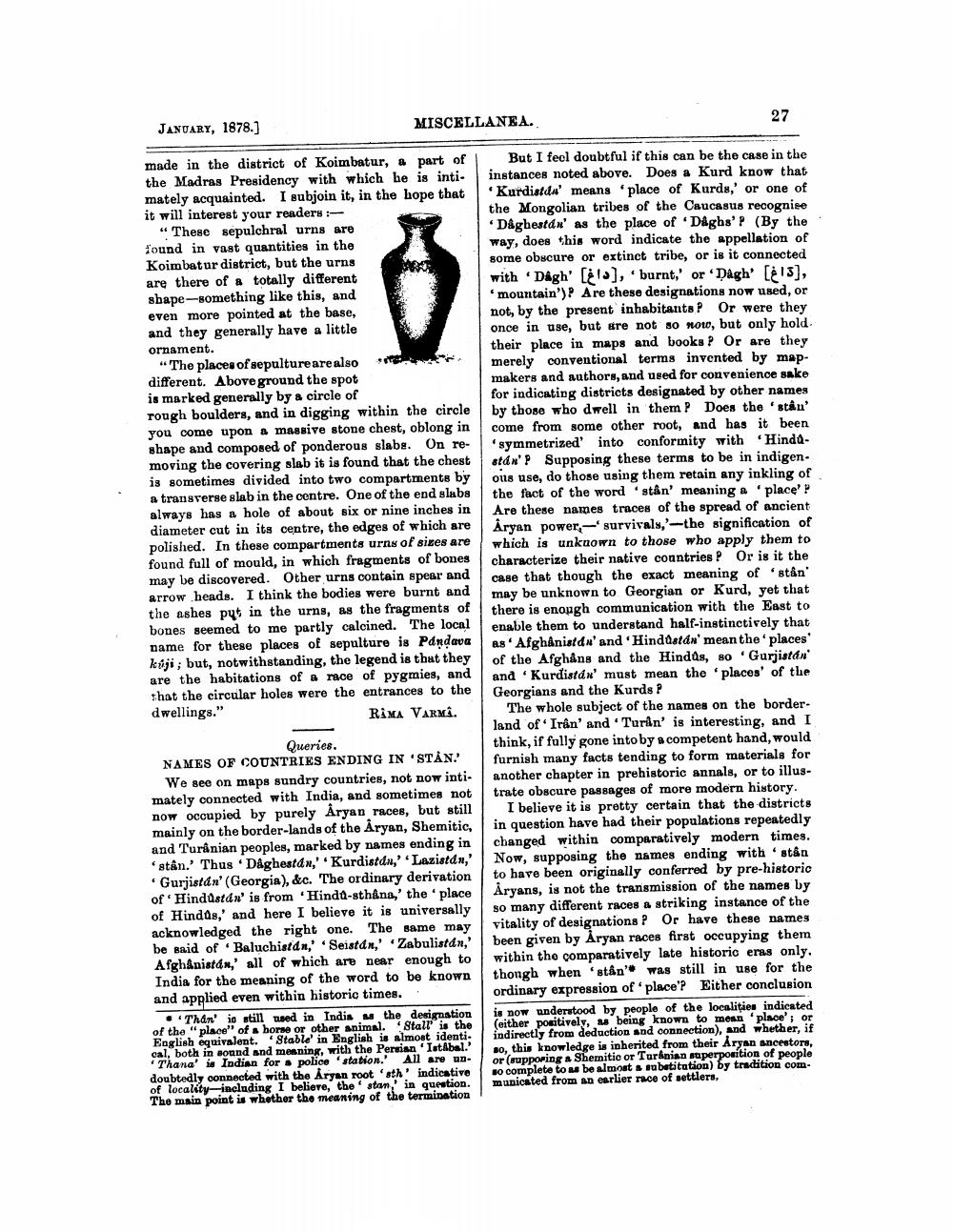________________
JANUARY, 1878.]
MISCELLANEA.
27
made in the district of Koimbatur, & part of But I feel doubtful if this can be the case in the the Madras Presidency with which he is inti- instances noted above. Does a Kurd know that mately acquainted. I subjoin it, in the hope that Kurdistdu' means place of Kurds,' or one of it will interest your readers :
the Mongolian tribes of the Caucasus recognise "These sepulchral urns are
D&ghestan' as the place of Daghs' P (By the found in vast quantities in the
way, does this word indicate the appellation of Koimbatur district, but the urns
some obscure or extinct tribe, or is it connected are there of a totally different
with Dagh' [113], burnt,' or Dagh' [13], shape--something like this, and
mountain')? Are these designations now used, or even more pointed at the base,
not, by the present inhabitants ? Or were they and they generally have a little
once in use, but are not so now, but only hold ornament.
their place in maps and books? Or are they "The places of sepulture are also
merely conventional terms invented by mapdifferent. Above ground the spot
makers and authors, and used for convenience sake is marked generally by a circle of
for indicating districts designated by other names rough boulders, and in digging within the circle by those who dwell in themP Does the stân' you come upon a massive stone chest, oblong income from some other root, and has it been shape and composed of ponderous slabe. On re- symmetrized' into conformity with "Hindamoving the covering slab it is found that the chest stan'P Supposing these terms to be in indigen. is sometimes divided into two compartments by ous use, do those using them retain any inkling of a transverse slab in the centre. One of the end slabs the fact of the word 'stân' meaning a place!! always has a hole of about six or nine inches in Are these names traces of the spread of ancient diameter cut in its centre, the edges of which are
Aryan power, survivals,'--the signification of polished. In these compartments urns of sizes are which is unknown to those who apply them to found full of mould, in which fragments of bones
characterize their native countries P Or is it the may be discovered. Other urns contain spear and case that though the exact meaning of 'stan' arrow heads. I think the bodies were burnt and
may be unknown to Georgian or Kurd, yet that the ashes put in the urns, as the fragments of
there is enough communication with the East to bones seemed to me partly calcined. The local
enable them to understand half-instinctively that name for these places of sepulture is Pandava As Afghanistd' and Hindustan' mean the places koji; but, notwithstanding, the legend is that they of the Afghans and the Hinds, so Gurjistán are the habitations of a race of pygmies, and and Kurdistan' must mean the places of the that the circular holes were the entrances to the Georgians and the Kurds ? dwellings."
RIMA VARM.
The whole subject of the names on the border
land of Irân' and 'Turân' is interesting, and I Queries.
think, if fully gone into by a competent hand, would NAMES OF COUNTRIES ENDING IN 'STÅN.
furnish many facts tending to form materials for We see on maps sundry countries, not now inti- another chapter in prehistoric annals, or to illusmately connected with India, and sometimes not trate obscure passages of more modern history. now occupied by purely Áryan races, but still I believe it is pretty certain that the districts mainly on the border-lands of the Aryan, Shemitic, in question have had their populations repeatedly and Turânian peoples, marked by names ending in changed within comparatively modern times. *stân.' Thus Dåghestán,' Kurdistdu,'Lazistdn,' Now, supposing the names ending with stân
Gurjistán' (Georgia), &c. The ordinary derivation to have been originally conferred by pre-historic of Hindustan' is from 'Hindd-sthana,' the place Aryans, is not the transmission of the names by of Hindus,' and here I believe it is universally so many different races a striking instance of the acknowledged the right one. The same may vitality of designations? Or have these names be said of Baluchistan, Seistar, Zabulistan, been given by Aryan races first occupying them Afghánistán,' all of which are near enough to within the comparatively late historic eras only, India for the meaning of the word to be known thongh when stân' was still in use for the and applied even within historic times.
ordinary expression of place'? Either conclusion • Than' is still used in India - the designation is now understood by people of the localities indicated of the "place" of borse or other animal. Stall is the (either positively, as being known to mesn place'; or English equivalent. Stable in English is almost identi. indirectly from deduction and connection), and whether, if cal, both in sound and meaning, with the Persian 'IstAbal.' No, this knowledge is inherited from their Aryan ancestors,
Thana' is Indian for a police station. All are un or (supporing a Shemitic or Turanian superposition of people doubtedly connected with the Aryan root 'sth' indicative Bo complete to as be almost sobatitution) by tradition comof locality including I believe, the stan,' in question. municated from an earlier race of settlers, The main point is whether the meaning of the termination




